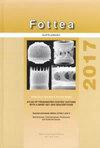Analysis and critical evaluation of structural features in four Cymbellaceae taxa from New Caledonia
IF 1.4
3区 生物学
Q3 PLANT SCIENCES
引用次数: 4
Abstract
Delicatophycus costei (Lange-Bertalot et Moser) Wynne, Cymbella bourrellyi Maillard, Cymbella latarea Maillard and Cymbella pernodensis Maillard are endemic to New Caledonia and show uncommon morphological features compared to the "sensu stricto" definition of their respective genus. Delicatophycus costei was described based on light microscopy and scanning electron microscopy (SEM) observations, confirming the generic LM diagnosis. However, the external view in SEM is atypical as both valve face and mantle are covered by longitudinal ribs, overlaying part of the zig-zag striae, generally accepted as the determinant generic feature. The three species of Cymbella have both apical pore fields and "stigmata". However, they show some specific morphological features compared to the more classically shaped Cymbella species. Cymbella bourrellyi has a narrow hyaline area on the valve face and the areolae are bordered internally by small outgrowths. Cymbella pernodensis is distinguished by internal biseriate striae. The internal morphology of Cymbella latarea is characteristic in having typical biseriate striae and bisected apical pore fields. In these three species, internally, the stigmata are continuous with the striae and appear as simple and only weakly separated structures at the end of the striae. The three species are also characterized by differences in the number of areola rows per stria externally and internally.新喀里多尼亚四个苏铁科植物结构特征的分析与评价
Delicatophycus costei(Lange Bertalot et Moser)Wynne、Cymbella bourrelli Maillard、Cymbela latarea Maillard和Cymbella pernodensis Maillard是新喀里多尼亚的特有种,与各自属的“严格意义”定义相比,它们表现出不同寻常的形态特征。根据光学显微镜和扫描电子显微镜(SEM)的观察结果描述了costei Delicatophycus,证实了LM的一般诊断。然而,SEM中的外部视图是非典型的,因为阀面和地幔都被纵向肋条覆盖,覆盖着部分之字形条纹,通常被认为是决定性的一般特征。这三个物种的辛贝既有顶端孔领域和“柱头”。然而,与更经典形状的苏铁属物种相比,它们表现出一些特定的形态特征。博氏隔在瓣膜表面有一个狭窄的透明区域,乳晕内部有小的突起。大花苏贝以内部的双列条纹为特征。宽花辛贝的内部形态特征是具有典型的双列条纹和平分的顶端孔隙区。在这三个物种中,柱头在内部与条纹连续,在条纹末端表现为简单且仅微弱分离的结构。这三个物种的特征还在于每个纹的乳晕行数在外部和内部的差异。
本文章由计算机程序翻译,如有差异,请以英文原文为准。
求助全文
约1分钟内获得全文
求助全文
来源期刊

Fottea
生物-植物科学
CiteScore
4.00
自引率
9.10%
发文量
20
审稿时长
>12 weeks
期刊介绍:
Fottea is a journal of Czech Phycological Society (formerly bulletin Czech Phycology). Fottea publishes papers on all aspects of the ecology, physiology, biochemistry, cell biology, molecular biology, systematics and uses of algae (including cyanobacteria)
 求助内容:
求助内容: 应助结果提醒方式:
应助结果提醒方式:


